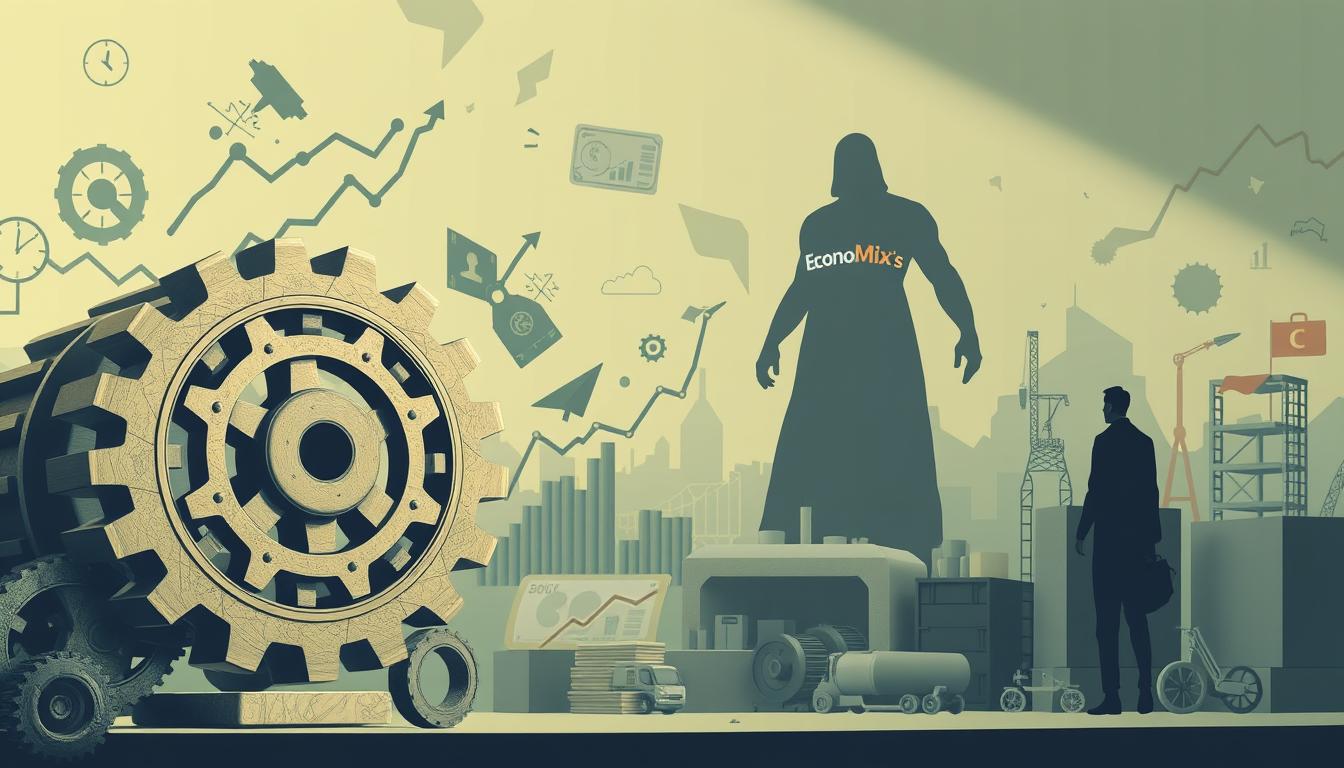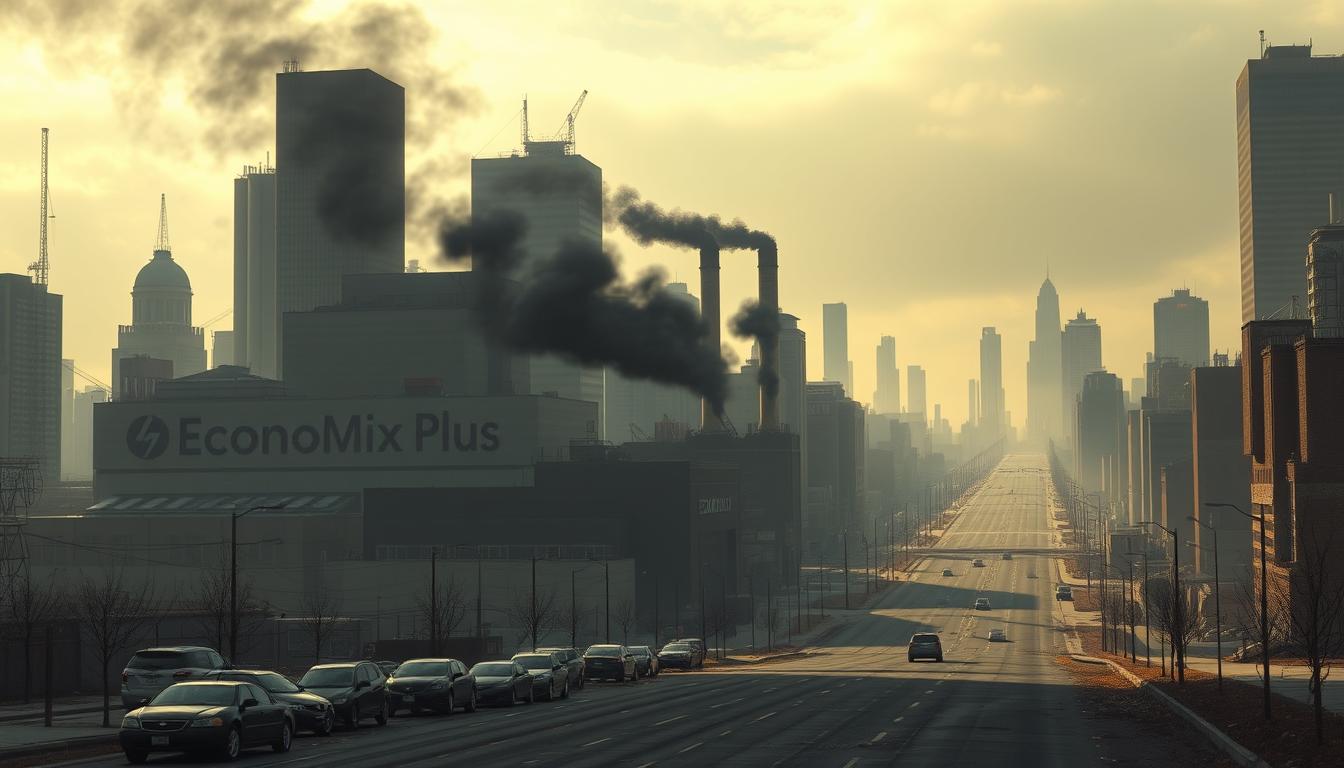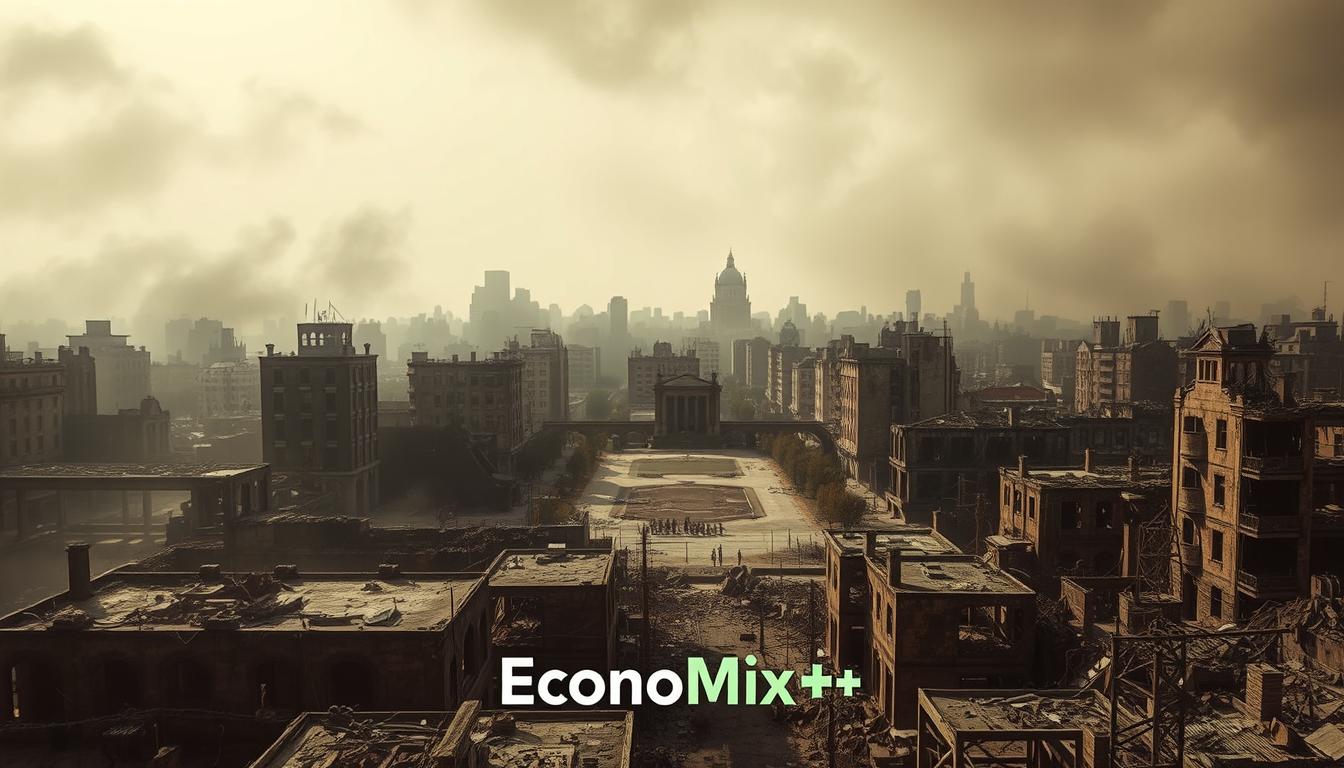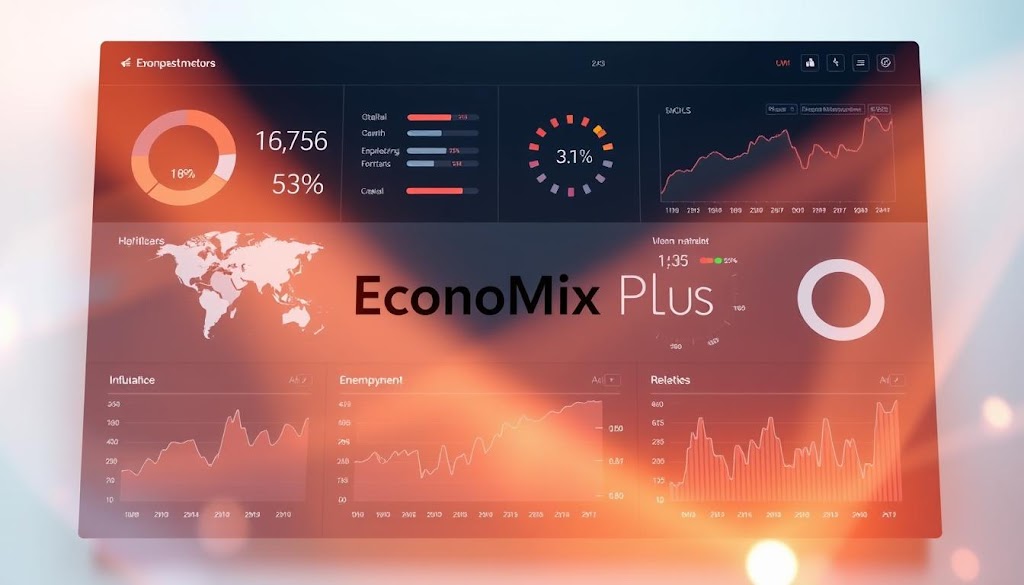Do you know how changes in prices can affect your money? It’s important to understand the difference between economic terms like inflation and deflation. They play a big role in monetary policy and your investments.
Recent news from The Wall Street Journal and Business Wire shows why knowing about inflation and deflation matters. These economic states are not just ideas. They affect supply and demand, consumer behavior, and the whole financial markets
When you’re dealing with the economy, knowing the difference between inflation and deflation is key. It helps you make better choices for your investments and financial plans.
Key Takeaways
- Understanding inflation and deflation is key for smart financial choices.
- Monetary policy is vital in managing prices.
- Economic indicators give clues about inflation or deflation.
- Consumer behavior and supply and demand change with inflation and deflation.
- Financial markets are influenced by inflation and deflation changes.
The Fundamentals of Economic Price Levels
It’s important to understand economic price levels to know how inflation and deflation affect your money. These levels show the average cost of things like food and housing. They tell us how well an economy is doing.
Changes in prices can really change how people spend money and how stable the financial markets are. If prices go up or down, it changes how much you can buy. It also changes how much you might want to spend.
The Concept of Price Stability in an Economy
Price stability means prices don’t change too much. It’s what many central banks aim for. It helps keep the economy stable, as the Wall Street Journal points out. Keeping prices stable is key to stopping deflation, which can slow down the economy.
- Stable prices help in planning for the future.
- They reduce the uncertainty that can deter investment.
- A stable economic environment encourages consumer spending.
How Price Levels Affect Your Daily Life
Prices in an economy affect how much you can buy with your money. If prices go up, your money doesn’t go as far. If prices go down, your money can buy more. Knowing this helps you make smart choices about saving and investing.
For example, when inflation is high, you might need to spend less or look into investments that do well when prices rise.
Defining Inflation: When Your Money Buys Less
Inflation can really affect your money’s value. It’s important to know why it happens and how it impacts you. In simple terms, inflation means prices for things like food and housing go up over time.
The Technical Definition of Inflation
Technically, inflation is when prices for goods and services go up. This makes your money worth less. The Consumer Price Index (CPI) is often used to measure this.
Common Misconceptions About Inflation
Many think inflation is always bad. But, a little inflation can mean the economy is growing. It’s the rate that’s key; too much inflation can hurt your savings, while too little might mean the economy is slow.
Types of Inflation You Should Know
Inflation comes in a few main types, mainly demand-pull and cost-push.
Demand-Pull Inflation
Demand-pull inflation happens when people want more than what’s available. This pushes prices up. It usually happens when the economy is strong and people are willing to pay more.
Cost-Push Inflation
Cost-push inflation occurs when making things costs more. This could be because of higher wages or raw materials. Businesses then raise their prices to keep their profits up.
| Type of Inflation | Cause | Effect |
|---|---|---|
| Demand-Pull Inflation | Excessive demand | Prices rise due to high demand |
| Cost-Push Inflation | Increased production costs | Prices rise due to higher costs |
For example, Henry Schein’s financial results, as reported by Business Wire, show how inflation affects businesses. It’s about how they price things and manage costs. Knowing about these types of inflation helps you make better financial choices.
Defining Deflation: When Your Money Buys More
When your money can buy more, it’s not always good news. This is what deflation is all about. It’s when the prices of things we buy go down over time.
The Technical Definition of Deflation
Deflation happens when prices drop below 0%. This means your money can buy more stuff than before. It’s like your money stretches further.
Why Deflation Isn’t Always Good News
Having more money to spend sounds great, but deflation isn’t always good. It can make people spend less, waiting for prices to drop even more. This can slow down the economy.

Types of Deflation in Economic Theory
There are different kinds of deflation, each with its own reasons and effects. Knowing about these types helps us understand deflation better.
Good Deflation
Good deflation happens when we get better at making things. This means lower costs and prices. It’s a sign of a healthy economy.
Bad Deflation
Bad deflation is caused by people spending less or money getting tighter. This can lead to slower economic growth. It’s not good for the economy.
The Wall Street Journal says, “Deflation can mean a slow economy, but it can also show we’re getting better at making things.” Knowing the difference is key to smart money choices.
“Deflation, when caused by increased productivity, can be a boon to consumers. But when it’s a result of weak demand, it can signal economic trouble.”
Inflation vs. Deflation: What’s the Real Difference and Why It Matters?
Understanding the difference between inflation and deflation is key. Both impact how much your money can buy, but in different ways.
Comparative Analysis of Price Level Changes
Inflation means prices go up, making your money worth less. Deflation, on the other hand, means prices fall, making your money worth more.
Key differences:
- Inflation: Makes money lose value over time.
- Deflation: Makes money gain value over time.
The Significance for Economic Stability
Inflation and deflation both affect the economy’s stability. Moderate inflation can signal growth, but high inflation can hurt savings. Deflation can cause people to spend less.
Short-term vs. Long-term Implications
Inflation can boost the economy in the short term. But, long-term inflation can be bad. Deflation can start a cycle of lower demand and prices.
Balance and Moderation in Economic Systems
A healthy economy usually has low, stable inflation. Too much inflation or deflation is bad.
The table below shows the main differences and effects:
| Economic Indicator | Inflation | Deflation |
|---|---|---|
| Price Level | Increases | Decreases |
| Purchasing Power | Decreases | Increases |
| Economic Impact | Can stimulate economy if moderate | Can lead to reduced spending |

The Primary Causes of Inflation
Inflation is a complex economic issue that affects how much things cost. Knowing what causes it helps you make smart money choices and deal with economic ups and downs.
There are several reasons for inflation, which we can group into three main areas. These are demand-pull factors, cost-push elements, and monetary expansion. Each one is important in its own way.
Demand-Pull Factors in Inflation
Demand-pull inflation happens when people want more than what’s available. This makes businesses raise their prices because they know customers are willing to pay more. Increased spending by consumers, government, and foreign demand for our goods are big reasons for this.
When demand is higher than supply, prices go up. This is because businesses want to make more money. It’s a cycle that can make things more expensive for everyone.
“The general theory of inflation is that it’s caused by an increase in demand relative to supply.”
Cost-Push Elements That Drive Prices Up
Cost-push inflation is about higher production costs. This includes things like higher wages and prices for raw materials. When costs go up, businesses often raise their prices to make more money. Supply chain issues, higher commodity prices, and labor costs are big factors here.
For example, if oil prices go up, it can make transportation more expensive. This can then lead to higher prices in many areas.

Monetary Expansion and Its Effects
Monetary expansion, often caused by central bank actions, can also lead to inflation. When there’s more money around, the value of money goes down. This means prices can go up. Actions like quantitative easing can add to the money supply and boost demand, but can cause inflation if not managed right.
It’s key for those in charge to find the right balance. They need to make sure money growth doesn’t lead to too much inflation.
The Primary Causes of Deflation
It’s important to know why deflation happens to make smart money choices. Deflation is when prices for things like food and housing go down over time. Several main reasons can cause this.
Decreased Demand and Consumer Spending
When people spend less, deflation can occur. Businesses then cut prices to try to sell more. This can happen for many reasons, like fear of the economy or losing faith in the future.
Technological Innovation and Productivity Gains
New technology can also lead to deflation. With better ways to make things, costs go down. This means prices for what we buy can drop too. For example, using robots in factories can make things cheaper for us.
| Cause | Description | Example |
|---|---|---|
| Decreased Demand | Reduced consumer spending leads to lower prices. | Economic downturns |
| Technological Innovation | Improved productivity reduces production costs. | Automation in manufacturing |
| Monetary Contraction | Reduced money supply increases the value of money. | Central bank policies |
Monetary Contraction and Its Consequences
When central banks try to fight inflation, they might cause deflation. By making less money, each dollar becomes more valuable. But this can also make people spend less, which isn’t good for the economy.

Understanding deflation’s causes can guide your financial choices. In times of deflation, choosing the right investments is key. Look into things like bonds or stocks that pay dividends, as they often do well when prices are falling.
Historical Examples of Significant Inflation
Inflation has shaped economies in many ways. Looking at past examples helps us understand its causes and effects. It also shows us how to tackle it today.
The 1970s Stagflation in the United States
The 1970s saw a rare economic problem in the U.S. called stagflation. It meant the economy wasn’t growing and prices were rising. The 1973 oil embargo and too much money being printed were big reasons.
The inflation rate hit 14.8% in March 1980. The Federal Reserve, led by Paul Volcker, tightened money to fight inflation. This helped lower inflation but also caused a recession.

Modern Examples from Global Economies
Today, many countries face high inflation. Venezuela saw hyperinflation, making its money almost useless. Turkey’s inflation is high due to unusual money policies.
Brazil and Argentina have also seen high inflation. They had to take strict steps to keep their economies stable.
| Country | Peak Inflation Rate | Primary Cause |
|---|---|---|
| Venezuela | 1,350,000% (2018) | Excessive money printing |
| Turkey | 85% (2022) | Unconventional monetary policies |
| Brazil | 82% (1994) | Monetary expansion and fiscal deficits |
Lessons Learned from Inflationary Periods
Learning from past inflations is key. Monetary policy is vital in controlling inflation. Central banks must carefully balance growth and inflation risks.
Fiscal discipline is also critical. It prevents too much demand that can cause inflation. Knowing why inflation happens helps make better policies.
By looking at past inflations, we can understand better how to manage economies. We see the need for proactive policies to keep the economy stable.
Historical Examples of Significant Deflation
Deflationary periods in history teach us a lot. They show us how important it is to keep prices stable. Deflation, or falling prices, can hurt our economy a lot.
The Great Depression Era
The Great Depression lasted from 1929 to the late 1930s. It was a time of sharp price drops and economic slowdown. The world’s economy took a big hit, with trade falling by over 60%.
Many things caused this deflation. People spent less and invested less. Also, money policies were tight.
Key statistics from the Great Depression include:
| Year | Unemployment Rate (%) | GDP Change (%) |
|---|---|---|
| 1929 | 3.2 | -8.6 |
| 1933 | 24.9 | -13.0 |
Japan’s “Lost Decade” and Beyond
Japan’s economy slowed down from the 1990s. This period, known as the “Lost Decade,” saw prices fall. Many factors led to this, like falling asset prices and less spending.
Lessons Learned from Deflationary Periods
Looking at past deflation helps us understand it better. It teaches us how to fight deflation and keep the economy stable. Knowing these lessons helps us make better financial choices today.
How Inflation Is Measured in Modern Economies
Measuring inflation is complex and involves several key indicators. It’s vital for policymakers, businesses, and individuals to understand these metrics. This knowledge helps them make informed decisions.
Consumer Price Index (CPI) Explained
The Consumer Price Index (CPI) tracks the average price change of goods and services. It’s used by agencies like the Bureau of Labor Statistics in the United States. It shows how living costs are changing.
Producer Price Index (PPI) and Its Significance
The Producer Price Index (PPI) looks at the prices producers get for their output. It’s key because it hints at future consumer price changes. If PPI rises, it might mean higher costs for consumers later on.
Other Important Inflation Metrics
There are other key inflation metrics too, like the GDP Deflator and Core Inflation Measures.
GDP Deflator
The GDP Deflator measures inflation across all goods and services in an economy. It’s found by dividing nominal GDP by real GDP.
Core Inflation Measures
Core inflation measures exclude food and energy prices. This gives a clearer view of underlying inflation trends. It helps policymakers understand persistent inflation pressures better.
As Alan Greenspan, former Chairman of the Federal Reserve, once said,
“The challenge of monetary policy is to interpret the signals from the economy and to respond appropriately.”
How Deflation Is Measured and Tracked
Measuring deflation is a complex task. It involves looking at economic indicators and price indices. These tools help us see how prices change over time.
Price Indices in Deflationary Environments
In times of deflation, price indices are very important. They show how fast prices are dropping. The Consumer Price Index (CPI) is a key one. It tracks the prices of goods and services for households.
Key price indices used to measure deflation include:
- Consumer Price Index (CPI)
- Producer Price Index (PPI)
- GDP Deflator
Economic Indicators That Signal Deflation
There are also economic indicators that warn of deflation. These signs help us understand the economy’s health. They help predict when prices might drop.
Output Gaps
An output gap happens when what we produce is less than what we could. This means resources are not being used fully. It can push prices down.
Velocity of Money
The velocity of money shows how fast money moves through the economy. If it slows down, it might mean less spending. This could lead to deflation.
| Economic Indicator | Description | Relation to Deflation |
|---|---|---|
| Output Gap | Difference between actual and potenial output | Negative output gap can lead to deflation |
| Velocity of Money | Rate at which money is spent and respent | Decrease can signal reduced economic activity and potenial deflation |
The Impact of Inflation on Your Purchasing Power
Inflation can hurt the value of your savings and income. As prices go up, your money can buy less than it used to. This problem affects everyone, from shoppers to businesses, and can harm the economy.
How Inflation Affects Your Savings
Inflation can make your savings worth less over time. For example, if you save $1,000 and inflation is 3%, that $1,000 will lose 3% of its value each year. After 10 years, it could be worth half as much. “Inflation is a silent killer of savings,” experts say, highlighting the need to protect your wealth.
Strategies to Preserve Wealth During Inflation
To fight inflation, you need to use smart strategies. Two good ways are investing in real assets and profit-sharing or equity-based options.
Ethical Investment in Real Assets
Investing in real assets like real estate or commodities can shield you from inflation. These assets often grow in value, keeping up with or beating inflation. For instance, investing in a real estate investment trust (REIT) focused on green properties can be both good for the planet and your wallet.
Profit-Sharing and Equity-Based Alternatives
Profit-sharing plans or equity investments are also smart choices. They offer growth chances and a share in company profits, helping protect against inflation. Look into companies known for their strong performance and ethical practices.
By using these strategies, you can safeguard your wealth from inflation’s damage. This way, you can keep your buying power steady over time.
The Impact of Deflation on Your Financial Decisions
Deflation changes how you make financial choices. It’s key to understand its effects. When prices drop, money’s value goes up. But, not everyone benefits from this.
The Effect on Cash Holdings and Savings
Deflation makes your cash and savings more valuable. For example, if you save $10,000, it can buy more as prices fall.
Key benefits of deflation on savings:
- Increased purchasing power
- Higher value of cash holdings
- Potential for increased savings rate
Ethical Investment Strategies During Deflation
Deflation needs a careful investment plan. Ethical investments can guide you through tough times while staying true to your values.
Value-Based Investment Approaches
Investing in companies that care about the planet and people is smart. These businesses tend to do well even when the economy is shaky.
Community-Focused Economic Participation
Supporting local businesses and projects helps your community and can be profitable. Look into community development financial institutions (CDFI) or local cooperatives.
By choosing these paths, you can make smart, deflation-proof choices. And you’ll stay true to your values.
Inflation’s Effect on Different Asset Classes
It’s important to know how inflation affects different assets. This knowledge helps you make better investment choices. Inflation can change the value of various assets, affecting your financial plan.
Real Assets: Real Estate and Commodities
Real assets like real estate and commodities do well when inflation is high. Real estate values often go up as prices rise. This makes real estate a good investment. Commodities like gold and precious metals also increase in value with inflation, acting as inflation hedges.
| Asset Class | Performance During Inflation |
|---|---|
| Real Estate | Tends to appreciate in value |
| Commodities (e.g., Gold) | Often serves as an inflation hedge |
Equities and Business Ownership
Investing in equities and business ownership can be tricky during inflation. Some companies face higher costs, while others can raise prices. Diversified portfolios with different industries can reduce risks from inflation.
Ethical Investment Alternatives
For those seeking ethical investments, there are options. Socially responsible investments and profit-sharing arrangements let you invest with your values in mind, even with inflation.
Socially Responsible Investments
Socially responsible investments focus on companies that follow ESG criteria. These investments can help you earn money while supporting good practices.
Profit-Sharing Arrangements
Profit-sharing lets investors share in a company’s success while promoting ethics. It’s a great choice for those who want to invest with their values.
Deflation’s Effect on Different Asset Classes
It’s important to know how deflation affects different investments. Deflation, or a general price drop, can change the value of various investments.
Cash and Currency Strength
During deflation, cash and currency values go up. This is because you can buy more with the same amount of money over time. Investors often choose cash and other liquid assets as a safe option.
Currencies like the US dollar may get stronger against others. This can affect international trade and investment.
Impact on Business Valuations
Deflation can hurt business valuations. Falling prices can lead to lower revenues and profits. This can make stock prices drop and reduce business investment. Companies with high costs are more at risk.
| Asset Class | Deflation Impact |
|---|---|
| Cash | Increases in value |
| Stocks | Generally decreases in value |
| Bonds | Typically increases in value |
Ethical Investment Considerations
Ethical investment is key during deflation. Investors seek companies that hold their value or help society, even in tough times.
Supporting Local Economies
Investing in local economies is a smart move during deflation. Supporting local businesses helps keep the economy and community strong.
“Investing in local businesses is not just about economic returns; it’s about building stronger, more resilient communities.”
Ethical Consumption Choices
Choosing ethical products and services is also important. Opting for sustainable and socially responsible companies is a way to invest ethically.
Government and Central Bank Responses
The role of government and central banks in managing economic ups and downs is huge. They play a key part in setting policies to fight inflation and deflation. This helps keep the economy stable.
To tackle inflation, governments and central banks use many policy tools. They adjust money supply and spending through monetary and fiscal policies.
Policy Tools for Managing Inflation
Central banks mainly use monetary policy to fight inflation. They change interest rates and control money supply.
Fiscal Policy Approaches
Governments use fiscal policy to control inflation too. They adjust spending and taxes. Lower spending and higher taxes can cut demand and slow inflation.
Supply-Side Interventions
Supply-side policies aim to boost the economy’s ability to produce. This lowers costs and prices. Investing in education and deregulating industries are examples.
Policy Approaches to Combating Deflation
Fighting deflation needs special strategies. Central banks and governments must work together to boost demand and stop deflation.
Public Spending Initiatives
Governments can increase public spending to raise demand. This includes funding for infrastructure, social programs, and more. It injects money into the economy.
Structural Economic Reforms
Introducing structural reforms can make the economy more efficient and competitive. This includes labor market changes, better business environments, and more innovation.
In summary, governments and central banks have many policy tools to handle inflation and deflation. The right policy depends on the economic situation and the challenge at hand.
Preparing Your Finances for Either Scenario
To deal with inflation and deflation, having a good financial plan is key. It’s important to know how to keep your wealth safe when prices go up or down. By following ethical money practices and smart investment strategies, you can protect your financial future.
When inflation hits, think about putting money into real estate or commodities. These often do well when prices rise. But, if deflation comes, consider keeping cash or investing in stable assets. It’s vital to spread out your investments to manage risks.
Good money habits, like not taking on too much debt and saving for emergencies, are always smart. Keeping up with economic news and adjusting your plan can help you use your money wisely, no matter the economic state.
FAQ
▶
▶
▶
▶
▶
▶
▶
▶
▶
▶
▶
▶














